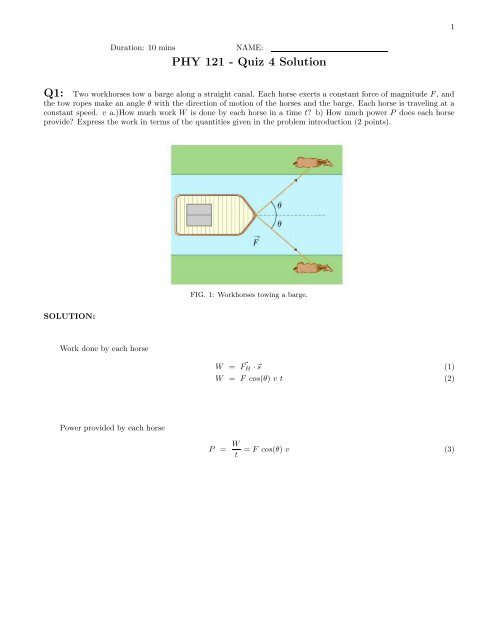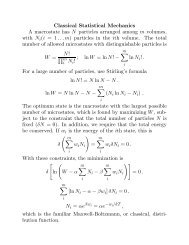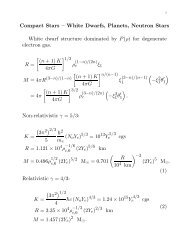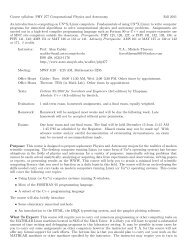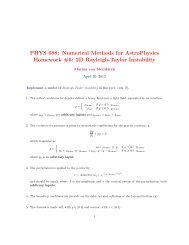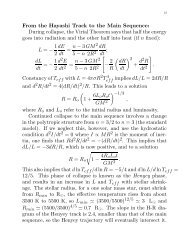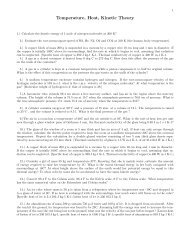PHY 121 - Quiz 4 Solution
PHY 121 - Quiz 4 Solution
PHY 121 - Quiz 4 Solution
- No tags were found...
Create successful ePaper yourself
Turn your PDF publications into a flip-book with our unique Google optimized e-Paper software.
1Duration: 10 minsNAME:<strong>PHY</strong> <strong>121</strong> - <strong>Quiz</strong> 4 <strong>Solution</strong>Q1: Two workhorses tow a barge along a straight canal. Each horse exerts a constant force of magnitude F , andthe tow ropes make an angle θ with the direction of motion of the horses and the barge. Each horse is traveling at aconstant speed. v a.)How much work W is done by each horse in a time t? b) How much power P does each horseprovide? Express the work in terms of the quantities given in the problem introduction (2 points).FIG. 1: Workhorses towing a barge.SOLUTION:Work done by each horseW =⃗ F H · ⃗s (1)W = F cos(θ) v t (2)Power provided by each horseP = W t= F cos(θ) v (3)
Q2: In this problem, you will calculate work done on an object moving in a straight line. Find the work done bythe 18-newton force W 18 , 30-newton force W 30 , 12-newton force W 12 , and 15-newton force W 15 (2 points).2FIG. 2: Work concept.SOLUTION:W = ⃗ F · ⃗s (4)W 18 = 18 × 160 × cos(0) = 2880.00 Joules (5)W 30 = 30 × 160 × cos(30) = 4156.92 Joules (6)W 12 = 12 × 160 × cos(180) = −1920.00 Joules (7)W 15 = 15 × 160 × cos(220) = −1838.50 Joules (8)Q3: You are a member of an alpine rescue team and must project a box of supplies, with mass m up an incline ofconstant slope angle α so that it reaches a stranded skier who is a vertical distance h above the bottom of the incline.The incline is slippery, but there is some friction present, with kinetic friction coefficient µ k . Use the work-energytheorem to calculate the minimum speed v that you must give the box at the bottom of the incline so that it willreach the skier. Express your answer in terms of some or all of the variables m, g, h, µ k , &α (2 points).SOLUTION:Potential energy of the system W P E ,Work done by the friction is given as W F ,W P E = −m g h (9)W F = −µ k dNcos(α) (10)Where d is the horizontal distance up the slope d = h/sin(α). From conservation of energy we can writeChange in Kinetic energy = Change in potential energy(K f − K i ) = (P f − P i ) (11)Which gives0 − 1 h2 mv2 = −m g h − µ k mgcos(α)sin(α)√ ()v = 2gh 1 + µ k cot(α)(12)(13)


